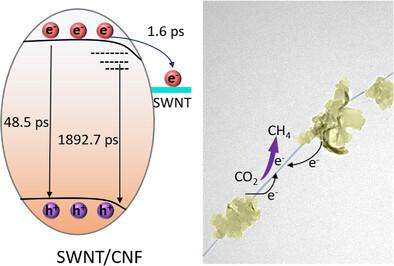通过坚固聚合物片段-单壁碳纳米管异质结工程增强光催化CO2还原
IF 26
1区 材料科学
Q1 CHEMISTRY, PHYSICAL
引用次数: 0
摘要
半导体异质结的构建是提高光催化CO2还原效率的一种很有前途的策略。然而,不同材料之间的弱界面相互作用往往会阻碍有效的电荷分离,这使得建立一个强大且连接良好的界面成为一个重大挑战。本文介绍了一种新的真空紫外辐照破碎技术,用于合成石墨化氮化碳碎片。这些碎片与单壁碳纳米管(SWNT)原位集成,形成SWNT/CNF异质结,优化了载流子动力学,提高了分离效率。密度泛函理论(DFT)计算表明,CNF通过将*CO加氢步骤从吸热(原始CN)转化为放热,从而稳定了临界*CHO中间体,从而在热力学上有利于甲烷的产生。所得的SWNT/CNF异质结构具有更高的比表面积和丰富的暴露活性位点。SWNT网络作为一个有效的电子高速公路,建立欧姆接触,延长光生载流子的寿命,抑制复合。因此,SWNT/CNF光催化剂的甲烷产率达到46.0µmol h g - 1,分别比原始CN和CNF提高了6.0倍和2.5倍,CH4的表观量子效率(AQE)达到0.96%,并且具有出色的循环稳定性。这项工作为工程稳健、高性能的氮化碳异质结提供了可扩展的策略,为更高效、更有选择性的CO2光还原铺平了道路。本文章由计算机程序翻译,如有差异,请以英文原文为准。

Enhancing Photocatalytic CO2 Reduction via Robust Polymer Fragment–Single-Walled Carbon Nanotube Heterojunction Engineering
The construction of semiconductor heterojunctions presents a promising strategy for enhancing the efficiency of photocatalytic CO2 reduction. However, the weak interfacial interactions between dissimilar materials often hinder effective charge separation, making the establishment of a robust and well-connected interface, a significant challenge. In this study, a novel vacuum ultraviolet (VUV) irradiation-driven fragmentation technique is introduced to synthesize graphitic carbon nitride fragments (CNF). These fragments are integrated in situ with single-walled carbon nanotubes (SWNT), forming a SWNT/CNF heterojunction with optimized charge carrier dynamics and improves separation efficiency. Density functional theory (DFT) calculations demonstrate that CNF thermodynamically favors methane production by converting the *CO hydrogenation step from endothermic (pristine CN) to exothermic, thereby stabilizing the critical *CHO intermediate. The resulting SWNT/CNF heterostructure exhibits a higher specific surface area with abundant exposed active sites. The SWNT network acts as an efficient electron highway, establishing Ohmic contact that prolongs the lifetime of photogenerated carrier and suppresses recombination. Consequently, the SWNT/CNF photocatalyst achieves a methane production rate of 46.0 µmol h g−1—representing 6.0-fold and 2.5-fold increases over pristine CN and CNF, respectively, along with an apparent quantum efficiency (AQE) of 0.96% for CH4 and exceptional cyclic stability. This work provides a scalable strategy for engineering robust, high-performance carbon nitride-based heterojunctions, paving the way for more efficient and selective CO2 photoreduction.
求助全文
通过发布文献求助,成功后即可免费获取论文全文。
去求助
来源期刊

Advanced Energy Materials
CHEMISTRY, PHYSICAL-ENERGY & FUELS
CiteScore
41.90
自引率
4.00%
发文量
889
审稿时长
1.4 months
期刊介绍:
Established in 2011, Advanced Energy Materials is an international, interdisciplinary, English-language journal that focuses on materials used in energy harvesting, conversion, and storage. It is regarded as a top-quality journal alongside Advanced Materials, Advanced Functional Materials, and Small.
With a 2022 Impact Factor of 27.8, Advanced Energy Materials is considered a prime source for the best energy-related research. The journal covers a wide range of topics in energy-related research, including organic and inorganic photovoltaics, batteries and supercapacitors, fuel cells, hydrogen generation and storage, thermoelectrics, water splitting and photocatalysis, solar fuels and thermosolar power, magnetocalorics, and piezoelectronics.
The readership of Advanced Energy Materials includes materials scientists, chemists, physicists, and engineers in both academia and industry. The journal is indexed in various databases and collections, such as Advanced Technologies & Aerospace Database, FIZ Karlsruhe, INSPEC (IET), Science Citation Index Expanded, Technology Collection, and Web of Science, among others.
 求助内容:
求助内容: 应助结果提醒方式:
应助结果提醒方式:


